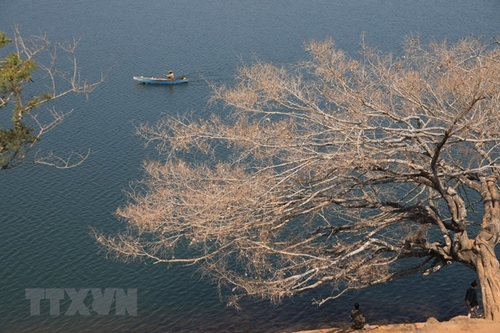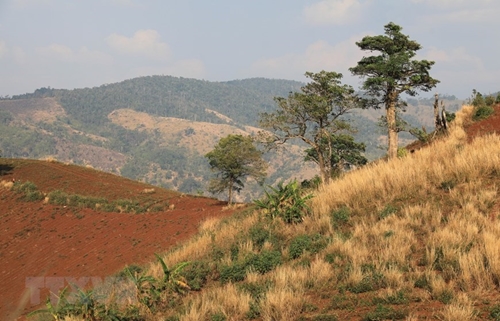Gia Lai is an ideal destination for travelers wanting to explore the wild nature and the unique culture of the Central Hughlands ethnic groups who are known for their gong heritage.
    |
 |
|
Bien Ho (Sea Lake), a beautiful place not far from Pleiku city, Gia Lai province |
When visiting Gia Lai, you do not need to go far to find beautiful scenery. Right in its provincial capital, Pleiku, you can find scenic Bien Ho (Sea Lake), Bien Ho Che (Tea Sea Lake), Chu Dang Ya and Ham Rong volcanoes and Chu mountain.
All you need is a motorbike to drive around in Pleiku in the sun and wind of the Central Highlands to reach the best sightseeing places in town. You can enjoy the gorgeous view of Bien Ho with its cool and clear air or wander in immense green tea hills in Bien Ho Che. You can also see beautiful wild sunflowers dyeing yellow the sides of old volcanoes which have slept for millions of years, or enjoy the wild and dreamy beauty of rubber forests in their season of changing leaves.
For those who love adventurous trips, Kon Chu Rang and Kon Ka Kinh (an ASEAN heritage park) national parks are recommended. The parks, which are perfect for trekking and camping overnight, boast gorgeous waterfalls and wild animals and plants.
    |
 |
|
Imposing landscape of mountains in Gia Lai province |
Not only endowed with pristine natural landscapes, Gia Lai is also a land imprinted with the cultural traits of the Central Highlands. The gong culture and old habits and practices of Central Highlands ethnic groups, including the Gia Rai, Ba Na, Mo Nong, Cho Ho, Xo Dang, E De, Chu Ru, S’tieng and Ro Mam, are the major attractions to this beautiful region.
The weather in Gia Lai was so nice in December, fully showing the beauty and prosperity of this bazan red soil region with red-ripening coffee plantations, immense green tea hills and rubber forests which are changing their leaves.
Apart from coffee, Gia Lai is a major grower of tea, rubber and pepper. In the Bien Ho Che area in Chu Pah, around 13 kilometers from Pleiku, there are vast tea hills with a total area of more than 1,100 hectares. The area was originally the French’s first tea plantation in Gia Lai in the 1920s. Gia Lai’s Bien Ho tea is a well-known brand which has received a certificate of high-quality Vietnamese farm produce by the Ministry of Agriculture and Rural Development. The tea is currently exported to Australia, Afghanistan, Pakistan and Singapore.
Gia Lai is also considered the rubber capital of the central highlands. The province has nearly 120,000 hectares of rubber with an annual output of nearly 290,000 tons of latex, which accounts for more than 30 percent of the country’s total output and quadruples the total output of the four remaining Central Highlands provinces.
Walking in huge rubber forests where the trees are changing their leaves in Dak Doa district, we could see Gia Lai’s big potential for the so-called “white gold.”
Gia Lai is now a major producer of farm goods in the Central Highlands, ranking second in the region in farming area with over 500,000 hectares of different crops. These include 120,000 hectares of rubber, 94,000 hectares of coffee, 17,000 hectares of cashews and nearly 17,000 hectares of black pepper.
Gia Lai has a total area of 15,500 km2 and is the second largest province in the country, and the largest in the Central Highlands. The province has the climate and soil conditions favorable for growing industrial crops such as coffee, rubber and pepper. With a population of over 1.4 million, including 34 ethnic groups with diverse and rich cultures and beautiful pristine scenery, Gia Lai has the advantages for developing tourism.
Source: VNA